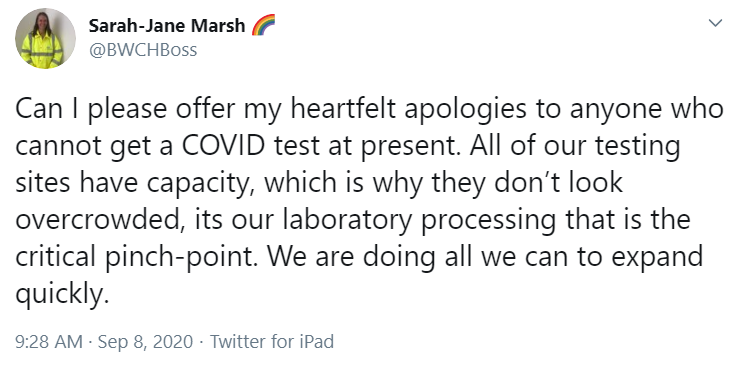Reports of serious problems with the UK’s coronavirus testing system first emerged around a week ago, with stories about people being asked to travel hundreds of miles to get a Covid-19 swab test.
Since then, official figures have since shown a recent fall in the number of people being tested each day in England.
There is clearly something going on. But getting answers from the UK government is proving to be a frustrating business.
Testing figures
Ministers tend to want to want to dwell on the UK’s “capacity” to do tests, rather than the actual numbers of people being tested.
Testing capacity “is based on reports from labs on how many tests they have capacity to carry out each day based on availability of staff and resources”.
This number is high, and going up, but it doesn’t tell us how well the rest of the system is functioning.
The latest figures for NHS Test and Trace in England show that 436,884 people were tested between August 27 and September 2.
That’s about 25,000 fewer people than the previous week, or a fall of nearly 6 per cent.
In other words, an average of 62,400 people were being tested a day in the latest figures, compared to a high of 66,000 a day. These are the lowest figures since the end of July.
Note that the latest stats only take us up to September 2. We’ll have to wait to find out what was happening at testing facilities across England in the last week, when there were widespread reports of people being unable to get a test within a hundred miles of home.
What is the official explanation?
On Tuesday Sarah-Jane Marsh, director of testing at NHS Test and Trace, posted a tweet offering her “heartfelt apologies to anyone who cannot get a COVID test at present”.
She added: “All of our testing sites have capacity, which is why they don’t look overcrowded, its (sic) our laboratory processing that is the critical pinch-point. We are doing all we can to expand quickly.”
This followed quotes from official sources which suggested that there had been a big spike in demand for testing and the government test booking website was prioritising high-risk areas.
On Wednesday the story took a new twist, with the Prime Minister, Boris Johnson, telling the House of Commons: “Demand is at an unprecedented high, particularly because of demand for asymptomatic patients.”
The Health Secretary, Matt Hancock, elaborated on this, saying: “In the last couple of weeks we have seen an increase in demand, including an increase in demand for people who are not eligible for tests, and people who don’t have symptoms.
“We have seen an increase of about 25 per cent of people who are coming forward that don’t have symptoms and aren’t eligible…
“We’ve got to be firmer, I’m afraid, with the rules around eligibility for testing.”
Changes to testing website
The Department of Health and Social Care have not published the data behind the “increase of 25 per cent” quoted by Matt Hancock.
But we do know that government advice on who should get tested – and the website used to book tests – have been changed in recent days.
Book a test today and the rules are clear. With a few narrow exceptions, you must have symptoms:
Archived versions of the same website from late last month show that more options were available to tick for people who might not have symptoms:
A subsequent page in the test booking system asked if you had symptoms, but answering “no” did not stop the booking process.
So it was possible until recently to book a coronavirus test online if you didn’t have symptoms of the illness. Can people be blamed for taking advantage of this feature?
Or did the government fail to make it clear that most people with no symptoms don’t need a test?
A spokesperson for the Department of Health and Social Care told FactCheck: “We have always been clear if you have symptoms of coronavirus, or are asked by a clinician or local authority to get a test, then you should apply for one.
“While our capacity is the highest it has ever been, we are seeing a significant demand for tests. That’s why we have simplified the booking process and updated guidance to make clear that if you do not have coronavirus symptoms and haven’t been asked, then you are not eligible for a test as this may prevent others who need one getting one.”
Distance travelled
Both Mr Hancock and Mr Johnson have suggested that the stories of people being told to drive for hours to get a test don’t tell the whole picture.
Boris Johnson said on Wednesday that: “The median journey is under 10 miles if someone has to take a journey to get one.”
Mr Hancock was even more precise yesterday, telling MPs: “The average distance travelled to a test site is 6.4 miles, and 90 per cent of people who book a test travel 22 miles or less.”
As with the 25 per cent increase in asymptomatic patients, the figures that back this up are not publicly available.
We understand that the Department of Health and Social Care may release the underlying statistics on average distance travelled in the future.
The verdict
UK government ministers have made a number of claims in defence of the Covid-19 testing regime in England, which is widely reported to have been experiencing problems in recent weeks.
Many of the claims are based on information which has not been made public, making them impossible to independently verify.
Matt Hancock has suggested in interviews that members of the public were using the testing system inappropriately.
But until recently, the system allowed people to book a test online even if they were asymptomatic, and the government has had to change the booking system to make the rules clearer.






